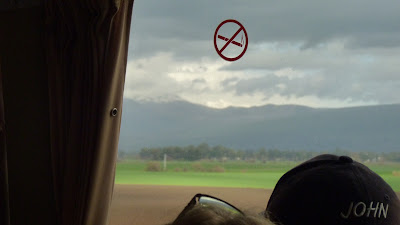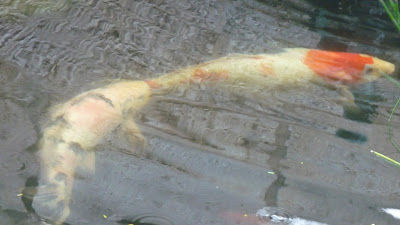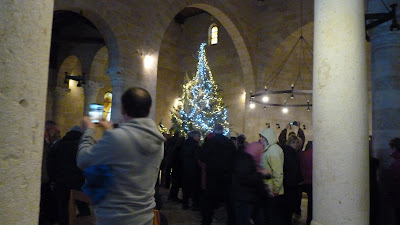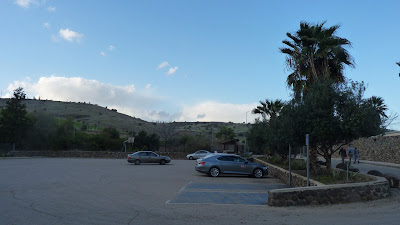After our St Peter's fish lunch we all got on the bus again for a ride to the far north of Israel. I am guessing this is the least populated region. It has high mountains and wild areas. Most of my photos came while riding the bus, but I want to remember what it looked like even if the photography is less than good.
Our guide told us that many birds migrated through the area. I saw a flock of cranes fling by, but couldn't get a photo of them.
In this wild region I also saw wild donkeys which had been reintroduced.
I seem to have gotten a street light in every picture.
January is winter and the rainy season, so there was lots of greenery.
And there were occasional villages.
And lots of empty wild regions.
And finally we reached Caesarea Philippi where the gates of Hell that will not be prevailed against is said to exist.
But, since it was about 2:30 on Friday afternoon, the site was closed early for the sabbath, shabbat, so the workers could get home to prepare.
Our guide had hoped that it would be open, but since the sun goes down early in winter, closed. As you might notice it was chilly and rainy up north.
The town was built by one of Herod's sons, who was not the one who beheaded John the Baptist. His wife who had gone to be with his brother is the one who demanded that.
Archaeologists are unearthing the site which was wet because of the overnight storm we had. So, they weren't working that day, and it was almost sabbath at any rate.
Lots of rocks in Israel and not that many trees makes for a lot of stone houses in ancient times.
There is a cave back against the hill were the town was built. According to our guide the cave was made as a temple were the "gods" were worshipped. It was called the Gates of Hell. When passing this town, Jesus referenced the gates of hell while teaching His apostles. But the gates of the national park on Friday afternoon prevailed against us.
So, after that, we drove back toward the Sea of Galilee to Tabgha, the site of the loaves and fishes.
There was an old church there. The site is maintained by the Franciscans.
The reason why traditionally this is thought to be the site of the feeding of the 5,000 is the 7 springs on the hillside. Besides bread and fish, the people would have needed water and this is the only hillside in Galilee with so many springs.
The spring where the church is located has been made into a pond. Koi have been introduced. It was hard to take a picture of these these.
All I could think of was living water. It was so peaceeful. The day and time of year meant that there were few other tourists or pilgrims at this site when we were there.
And I am not sure what kind of plant that is. I suspect if it wasn't bundled, there would be no room for the fish eventually.
The fish were getting big enough to eat.
The church was very old. It had a lot of old mosaics. I had seen this bird in some book before.
The church was rather dark and we couldn't walk on the mosaics, as was correct, but it was hard to get any decent photos.
My recollection is that the dark lower walls are basalt, and older. The limestone was built on top because the older church was destroyed in an earthquake.
The altar and church were very plain. All the ornamentation was on the floor in the form of the mosaics.
The stork mosaic was amazing. I was still wowed by the mosaics this early in the trip. We have amazing mosaics at our "new" cathedral in St Louis, but they are glass pieces, not rock, so they can produce any color. These mosaics were made of stones. The artists had to look for stones the colors that they needed for the picture.
It was mid-January and Christmas was still up all over the place. There was still the lighted tree in this church.
The display telling about Tabgha which I didn't have time to read. Tabgha sits near the Sea of Galilee. Note to self, photograph closer if you plan to try to read the display.
The church of the Seven Springs.
Looking toward the hillside were the people would have gathered.
On our way around the Sea of Galilee in the sprinkling rain.
Clouds and sun over the sea or lake.
Our guide told us that all the trees in Israel are planted. There is one day a year when everyone goes out and plants trees. They are restoring the land. This tree is probably an olive tree.
All the palms are date palms. Israel is an exporter of dates.
Because Casaerea Philippi was closed we were too early for dinner at the hotel. We had a little time to kill and not much was open because of the impending sabbath. Our guide knew of a little kibbutz store that luckily was open. Some of the group got Israeli wine to take home. I got some fruit infusion which is like fruit flavored tea.
Our dinner that night was shabbat, sabbath. There was bread and wine to share at the table. We got to pick from the buffet line, so all the foods were not traditional shabbat foods. But, I am told that all the servers were Arabs, not Jews. Hotels hire non-Jewish people so that they have workers for the shabbat. The elevators are set to stop at every floor during the shabbat. Pushing an elevator button would be considered work which is not premitted for Jews on shabbat.



































No comments:
Post a Comment